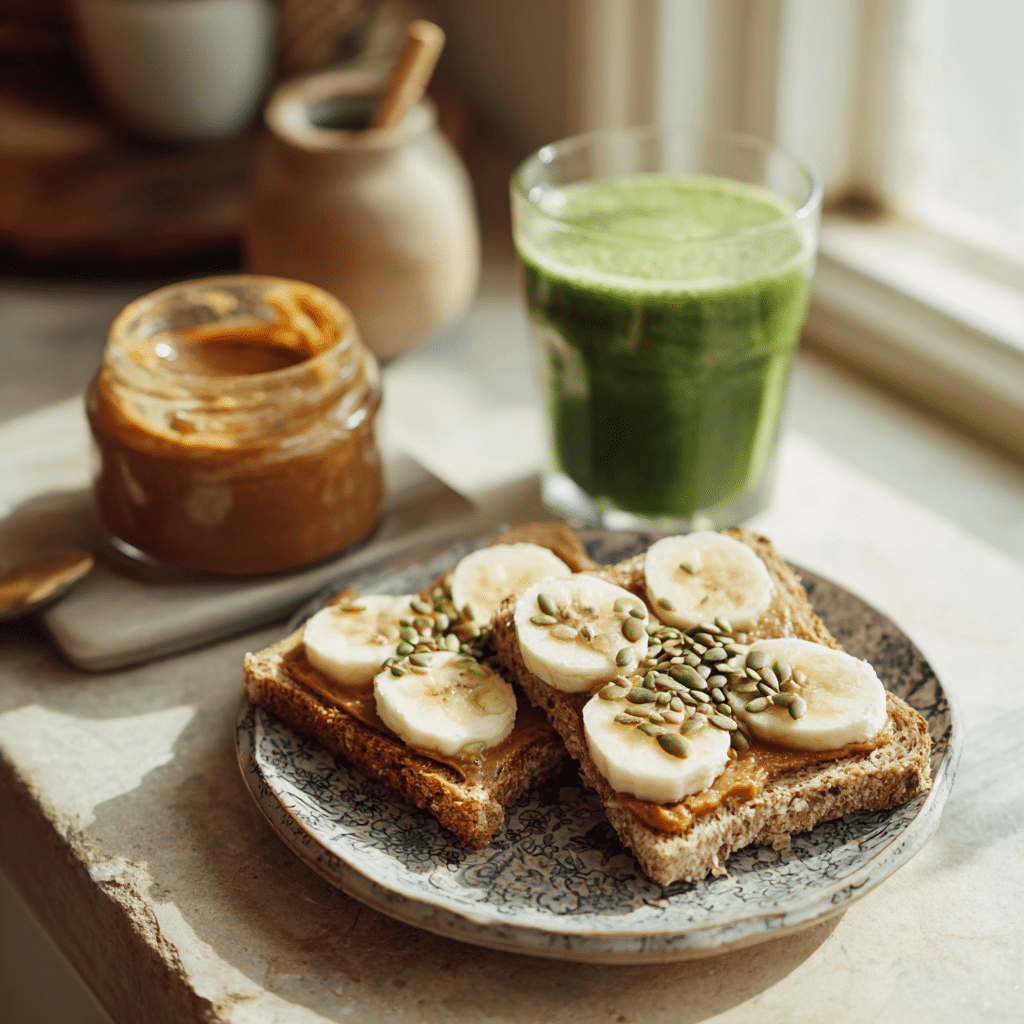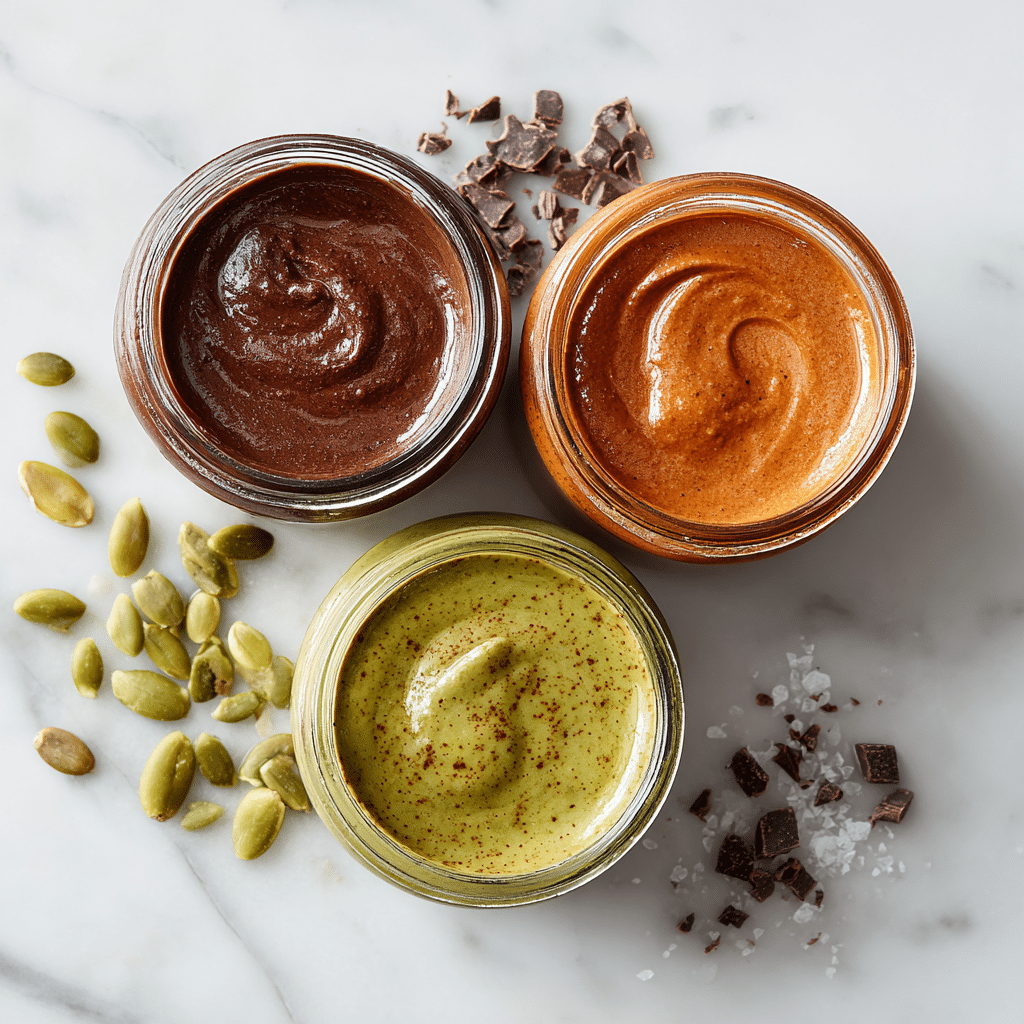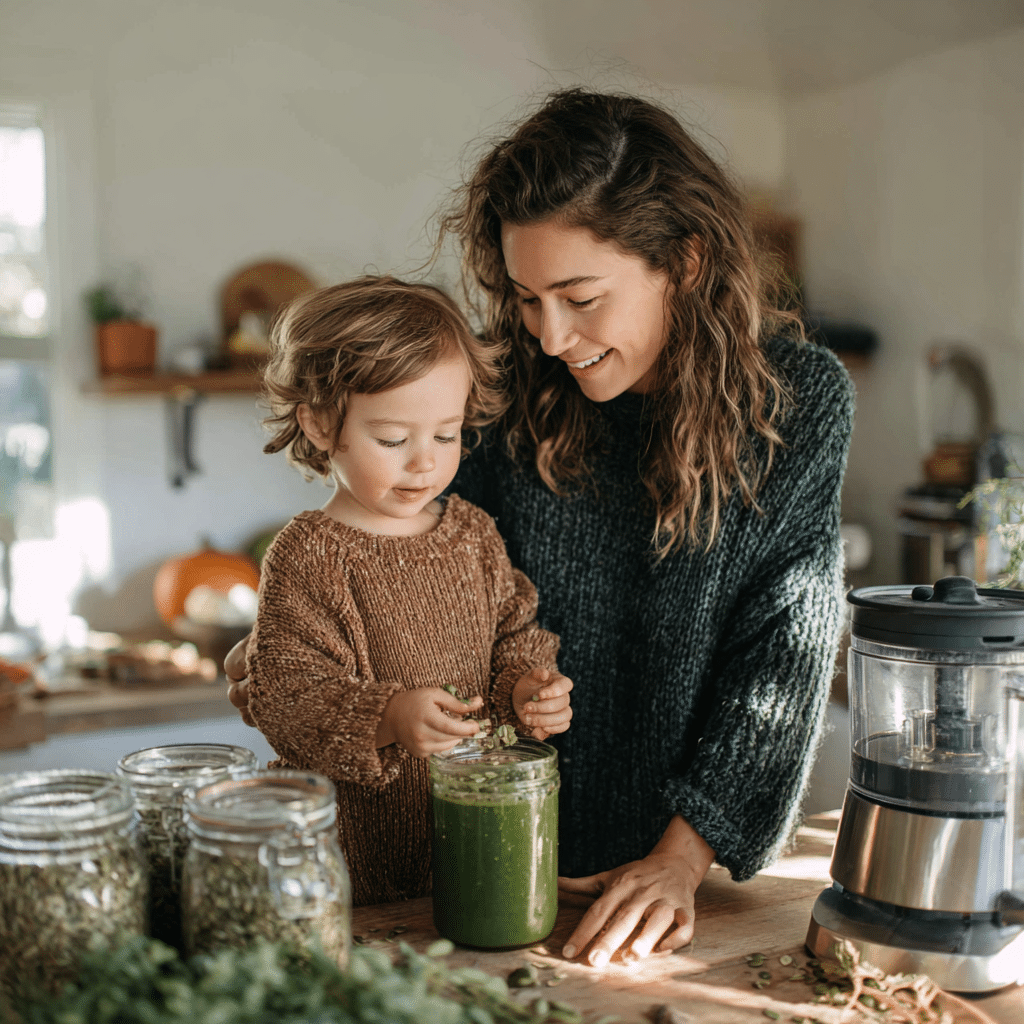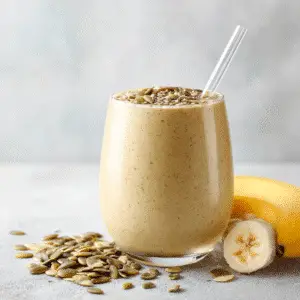Olivia never thought she’d ditch her store-bought spreads. That was until her toddler started refusing peanut butter, and her husband asked for something “nut-free but still creamy.” That’s when she found the magic of the butter pumpkin seed recipe.
What started as a quick experiment with roasted seeds, salt, and a food processor quickly turned into a kitchen favorite. The rich green color, earthy taste, and smooth texture made it an instant win. No additives. No sugars. Just two ingredients and a powerful nutritional punch.
This guide breaks down everything you need to know to make your own butter pumpkin seed recipe at home—faster, cheaper, and healthier than anything on a shelf.
Table of Contents

Beurre de Graines de Courge Maison
Ingredients
Equipment
Method
- Préchauffez le four à 150°C (300°F). Étalez les graines de courge sur une plaque de cuisson.
- Faites rôtir pendant 15 minutes en remuant à mi-cuisson. Laissez refroidir 5 à 10 minutes.
- Transférez les graines refroidies dans un robot culinaire. Mixez par impulsions pour les briser, puis continuellement pendant 15 à 20 minutes.
- Ajoutez le sel et l’huile si désiré. Continuez à mixer jusqu’à obtenir une texture lisse et brillante.
- Transférez dans un bocal en verre propre. Laissez refroidir complètement avant de fermer et stocker.
Notes
Ingredients and Tools for Homemade Pumpkin Seed Butter
Basic Ingredients (Pumpkin Seeds, Salt, Optional Oil)
Making your own butter pumpkin seed recipe at home is surprisingly simple. You only need two core ingredients—plus one optional boost to perfect texture.
Here’s what goes into a clean, creamy, and healthy spread:

- 2 cups raw pumpkin seeds – Hulled and unsalted (pepitas work best)
- 1 tsp sea salt – Enhances flavor without overpowering
- 1–2 tsp neutral oil (optional) – Use sunflower or almond oil for smoother consistency
The beauty of this recipe is in its flexibility. You can keep it plain for a raw pumpkin seed butter recipe, or toast the seeds for a roasted flavor. Both options work great and deliver different textures and taste profiles.
If you like sweetness, a pinch of cinnamon or a dash of vanilla extract can turn it into a delicious breakfast butter.
What Equipment Works Best: Food Processor or Blender
To get the smooth, spreadable texture of homemade pumpkin seed butter, you need the right equipment.
Here are your options:
| Tool | Pros | Notes |
|---|---|---|
| Food Processor | Best choice for thick, creamy consistency | Strong motor needed for 10–20 min blending |
| High-Speed Blender | Faster if using tamper (like Vitamix) | Must scrape sides often |
| Basic Blender | Not recommended unless using lots of oil | Often overheats or stalls |
If your machine starts to heat up, pause for a few minutes to protect the motor. Seed butter takes patience, but the results are worth it.
Pro tip: For a rich, roasted version, toast the seeds beforehand.
Already thinking of flavor combos? Try adding this butter to healthy air fryer honey bun cake for a protein-packed dessert upgrade.
Health Benefits of Butter Pumpkin Seed Recipe
Why Pumpkin Seeds Make a Perfect Nut-Free Butter
Pumpkin seeds aren’t just for roasting during fall. These small green seeds are packed with powerful nutrients that make them the perfect base for a creamy, nut-free butter.
People with nut allergies often struggle to find safe alternatives to peanut or almond spreads. That’s where pumpkin seed butter stands out. It’s naturally nut-free, gluten-free, and full of plant-based goodness.
When you follow a butter pumpkin seed recipe, you’re working with a seed that contains:
- Anti-inflammatory fats
- Antioxidant compounds
- Low risk of allergic reaction
- Mild, earthy flavor that pairs well with sweet or savory ingredients
Pumpkin seed butter is safe for school lunches, kid-friendly, and rich in essential nutrients. It’s also suitable for vegan and paleo diets, offering a flexible base for healthy meals.
Nutrients: Protein, Zinc, Iron, and Healthy Fats
Pumpkin seeds are nutritional all-stars. Here’s what makes them shine in any butter recipe:
- Plant-based protein: Around 7g per ounce. Supports muscle repair and energy.
- Magnesium: Essential for mood balance, nerve function, and blood pressure.
- Zinc: Supports immunity and skin health.
- Iron: Crucial for energy and oxygen flow.
- Vitamin E: An antioxidant that helps protect cells from damage.
- Omega-6 and omega-9 fats: These healthy fats promote heart health and help you stay full longer.
Together, these nutrients make pumpkin seed butter more than just a spread. It’s a simple way to add protein, fiber, and essential minerals to your day without added sugar or preservatives.
Try pairing it with your morning toast, smoothie bowl, or even a drizzle over low-calorie high-protein banana pancakes. One tablespoon can make a difference.
How to Make Butter Pumpkin Seed Recipe Step-by-Step
Roasting Seeds Properly (Why and How Long)
Roasting your seeds is optional—but highly recommended. It gives your homemade pumpkin seed butter a deep, nutty flavor and helps the oils release faster during blending.
Here’s how to do it right:
- Preheat oven to 300°F (150°C)
- Spread raw pumpkin seeds evenly on a baking tray
- Roast for 15 minutes, stirring once halfway through
- When seeds begin to smell toasty and look slightly golden, remove and cool for 5–10 minutes
If you’re using seeds from butternut squash, make sure to clean and dry them thoroughly first. You can adapt this into a roasted butternut squash seed recipe variation using the exact same steps.
Bonus tip: For a salted version, toss the seeds in a pinch of sea salt before roasting. This gives that butter and salt pumpkin seed recipe flavor people love.
Blending Process: Textures, Time, Tips to Smooth It Out
Once your seeds are roasted (or raw, if you prefer), transfer them into a food processor.
Follow these steps:

- Start pulsing in intervals to break down the seeds
- After 3–5 minutes, the mix becomes crumbly
- At 7–10 minutes, it forms a thick paste
- At 12–15 minutes, the oils release—blend turns creamy
- Add sea salt and optional oil to reach your ideal consistency
If your processor gets too hot, pause. Let it cool, then resume. The end result should be smooth, spreadable, and glossy.
Some people prefer their butter thinner. Add 1–2 tsp of almond or coconut oil to thin it out.
Want to get creative? Use it as a base for chocolate pumpkin seed butter recipe or swirl it into bold desserts like the pink salt trick recipe or banana strawberry shake recipe for added flavor and texture.
Variations of Pumpkin Seed Butter Recipes
Raw Pumpkin Seed Butter vs Roasted Version
There are two main approaches to any butter pumpkin seed recipe: raw or roasted. Each delivers a different taste and texture.
Raw pumpkin seed butter has a softer, earthier flavor. It’s slightly bitter but retains more enzymes and nutrients because the seeds aren’t heated. Perfect for purists or those following raw food diets.
Roasted pumpkin seed butter has a richer taste, thanks to the toasted oils. It blends faster and spreads smoother. Roasting also cuts the “green” flavor some find too intense in the raw version.
Tip: If you want to try raw, skip the oven step in Part 3. Just blend raw pepitas until creamy.
Want to compare flavors? Use half roasted, half raw seeds in your next batch. You’ll notice a big difference.
Chocolate, Vanilla, and Butter-and-Salt Flavor Twists
If plain seed butter feels too simple, upgrade it with sweet or savory add-ins.
Here are 3 popular twists:

- Chocolate Pumpkin Seed Butter Recipe
- Add 1 tbsp unsweetened cocoa powder and 1 tsp maple syrup
- Blend until smooth, rich, and dark. Use on toast or in desserts
- Try it swirled into healthy raspberry lemonade refresher for a summer surprise
- Vanilla Sweet Butter
- Add 1/2 tsp vanilla extract and a pinch of cinnamon
- Smooth, aromatic, and kid-friendly
- Use it as a spread on low-carb cinnamon rolls for a protein boost
- Butter and Salt Pumpkin Seed Recipe
- Use roasted seeds + flaky sea salt
- Add a splash of avocado oil for smoother texture
- Great as a savory dip for raw veggies or crackers
These variations transform a basic seed butter into something crave-worthy. And each one keeps the health benefits intact.
Storage Tips & Shelf Life
How Long Does Homemade Seed Butter Last?
A fresh batch of homemade pumpkin seed butter can last surprisingly long—if stored properly.
Here’s what you need to know:
- At room temperature (in a cool, dark cupboard): up to 2 weeks
- In the refrigerator: lasts 1–2 months
- In the freezer (airtight container): up to 6 months
Always store the butter in a clean glass jar with a tight lid. Keep it away from heat and light to avoid spoilage or oil separation.
You’ll know it’s time to toss it if:
- It smells sour or stale
- The oils separate and smell “off”
- It changes color or texture dramatically
If you’re making large batches, label each jar with a date. Use the oldest first. For best freshness, store it like you would natural peanut butter.
Want to boost shelf life? Add a teaspoon of coconut oil or vitamin E oil—it helps preserve freshness naturally.
Room Temp vs Fridge: What’s Safer and Tastier
Both storage methods work, but they affect taste and texture.
| Storage | Texture | Taste | Notes |
|---|---|---|---|
| Room Temp | Soft, spreadable | Stronger flavor | Best for quick use (under 2 wks) |
| Fridge | Firm | Milder flavor | Longer shelf life (up to 2 mo.) |
| Freezer | Frozen solid | Same as fresh | Thaw overnight before using |
Tip: Let refrigerated seed butter sit at room temp for 10 minutes before spreading. It softens naturally without altering flavor.
Pair your stored seed butter with gluten-free mozzarella sticks or marinated zaatar bean salad for a high-protein, savory combo.
Best Ways to Use Pumpkin Seed Butter Daily
Toast, Smoothies, Baking: How to Enjoy It
Once you’ve made your butter pumpkin seed recipe, the next step is using it creatively. This spread goes beyond toast.
Here are 6 easy, delicious ways to add pumpkin seed butter to your daily routine:

- On toast or rice cakes – Add sliced banana or honey for extra flavor
- In smoothies – Swap almond butter for a spoon of pumpkin seed butter for a nut-free boost
- With oatmeal or porridge – Drizzle it warm for a creamy, protein-rich topping
- As dip for apple or celery slices – Great snack for kids and adults
- In baked goods – Use it in cookies or muffins instead of nut butters
- Stuffed into dates – Combine with cinnamon for a natural dessert
Want to try something more filling? Spread it on scrambled egg toast with avocado or dip it into air fryer chicken tenders for a savory-sweet combo.
Pumpkin seed butter is versatile, subtle in flavor, and doesn’t overpower other ingredients. It adapts to sweet and savory dishes alike.
Healthy Pairings and Creative Recipe Ideas
Still wondering what goes with pumpkin seed butter? Here’s a cheat sheet of pairings that work every time:
| Pairing Type | Best Matches |
|---|---|
| Fruits | Apple, banana, pear, figs |
| Carbs | Whole grain toast, rice cakes, oat muffins |
| Veggies | Celery, carrots, cucumber sticks |
| Proteins | Greek yogurt, cottage cheese, boiled eggs |
| Dessert ideas | Stuffed dates, seed butter fudge, smoothies |
For a fun twist, combine pumpkin seed butter with tahini and honey for a Middle Eastern-style spread.
Or go sweet and creamy with matcha pound cake layered with a drizzle of pumpkin seed butter and maple syrup.
This spread is more than a topping—it’s an upgrade.

FAQs About Butter Pumpkin Seed Recipe
How is pumpkin seed butter made?
It’s made by roasting hulled pumpkin seeds, then blending them for 15–20 minutes in a food processor until smooth. Just add a pinch of salt—and oil if needed. See full method in our homemade pumpkin seed butter recipe.
Can you use butter to roast pumpkin seeds?
Yes. Melted butter adds flavor and helps crisp the seeds during roasting. It’s ideal for snacks but less useful in seed butter, where oil-free or neutral oil versions work better.
Is pumpkin seed butter healthy?
Absolutely. It’s high in plant protein, magnesium, zinc, and omega-6 fats. It’s nut-free, vegan, and supports immunity and energy without added sugar.
How to make seed butter at home?
Toast seeds, then blend on high for 15+ minutes. Scrape sides often. Add salt and oil to adjust texture. Try our full butter pumpkin seed recipe for exact steps.
How is pumpkin butter made?
Pumpkin butter is not seed-based. It’s made by cooking pumpkin purée with sugar and spices until thick, like a jam. Totally different from seed butter.
Why soak pumpkin seeds before roasting?
Some people soak to remove enzyme inhibitors. For butter-making, soaking isn’t needed—especially if you plan to roast them. Soaking adds moisture and delays blending.
What goes with pumpkin seed butter?
Fruits (apple, banana), whole-grain toast, smoothies, crackers, and even low-carb keto Big Mac salad make great pairings.
What are the benefits of eating pumpkin seeds daily?
Daily intake supports heart health, digestion, immunity, and may reduce inflammation. Just 1 tablespoon of seed butter offers protein, magnesium, and fiber.
Why is pumpkin seed butter green?
Pumpkin seeds contain chlorophyll, a natural green pigment. Blending enhances the color, especially when roasted.
Can we eat pumpkin seeds raw?
Yes, but always use hulled (green) seeds for easier digestion and better blending. Raw seeds work great in smoothies or raw bars.
What are the main ingredients in pumpkin seeds?
Pumpkin seeds contain protein, magnesium, iron, zinc, healthy fats, and antioxidants—ideal for natural energy and repair.
What is the white powder on pumpkin seeds?
It’s often natural salt residue or seed coating. If it smells sour or looks moldy, discard. Otherwise, it’s harmless.
How do you make pumpkin seeds?
Scoop seeds from the pumpkin, rinse, dry, and roast with oil or spices. See our butternut squash pumpkin seeds recipe for inspiration.
What is in seed butter?
Seed butter is typically made with just seeds and salt. Optional add-ins include coconut oil, vanilla, maple syrup, or cocoa powder.
Is pumpkin seed butter good?
Yes. It’s creamy, rich in minerals, easy to digest, and works in both sweet and savory dishes.
How to make your own pumpkin seed oil?
Making pumpkin seed oil at home requires pressing roasted seeds, which is difficult without equipment. Most people buy cold-pressed versions.
Conclusion
Making your own butter pumpkin seed recipe is simple, healthy, and rewarding. With just a few ingredients and 20 minutes of blending, you get a creamy, nutrient-dense spread packed with protein, fiber, and flavor.
Whether you prefer it raw or roasted, plain or chocolate-flavored, pumpkin seed butter is a smart swap for processed spreads. It supports energy, digestion, and heart health—and works for kids, vegans, keto fans, and anyone avoiding nuts.
Once you try it, you’ll never go back to store-bought jars. Start with one batch, mix in your favorite add-ins, and enjoy the green goodness every day.
Looking for your next smart kitchen move? Try it with greek yogurt parfait for weight loss or as a topping for low-calorie high-protein banana pancakes.
Hungry for more? Discover fresh recipes every day on BestyRecipe’s Pinterest & Facebook!



